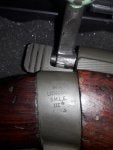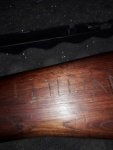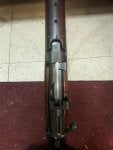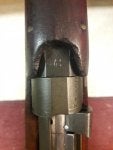I stopped at a New Bedford gun store today and looked at a very nice rifle. From my hasty notes, it was marked MA Lithgow SMLE III 1941 on the right wrist band, and MA Lithgow III HV 1941 on the right side of the stock. Serial# 75746, and the bolt was engraved with the matching no. The bore looked very sharp. Sling included.
There was a green stripe about an inch wide painted very neatly around the stock an inch or two back of the grip. I was wondering if this had any significance. I know some British-import US M1903s were painted with a red band to warn against the use of .303 ammo, and I wondered whether the green stripe is a similar warning, or in the vein of the "DP".
Nice rifle...they wanted $350 for it.
Ishmael
There was a green stripe about an inch wide painted very neatly around the stock an inch or two back of the grip. I was wondering if this had any significance. I know some British-import US M1903s were painted with a red band to warn against the use of .303 ammo, and I wondered whether the green stripe is a similar warning, or in the vein of the "DP".
Nice rifle...they wanted $350 for it.
Ishmael


















